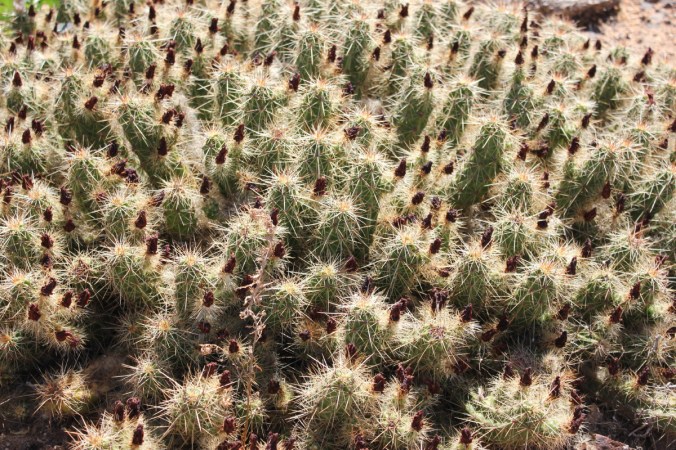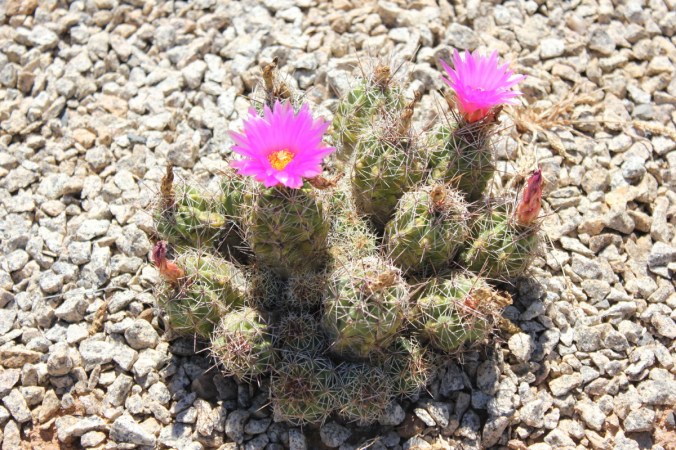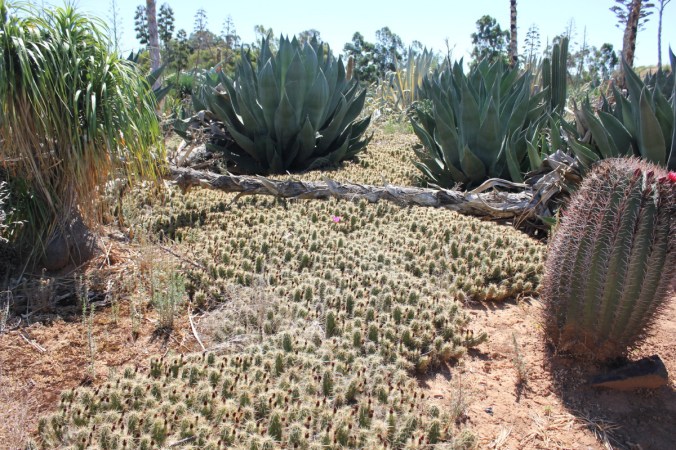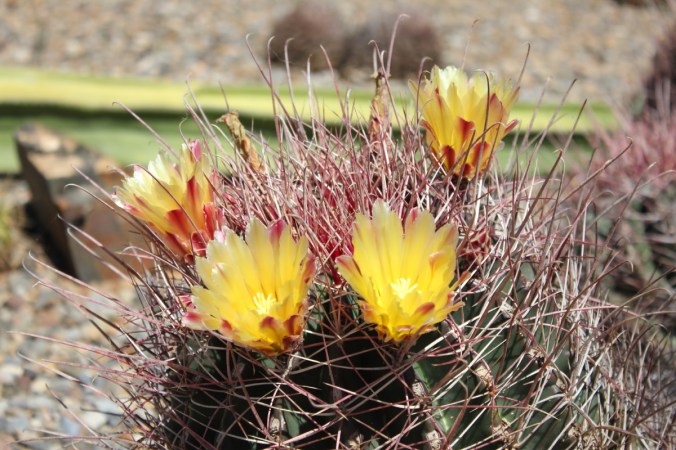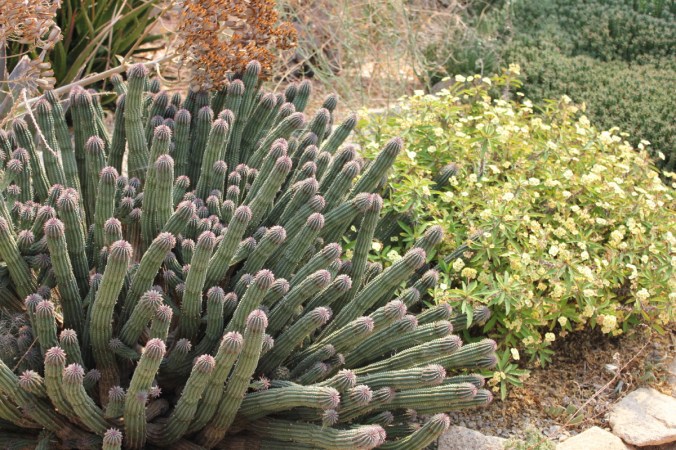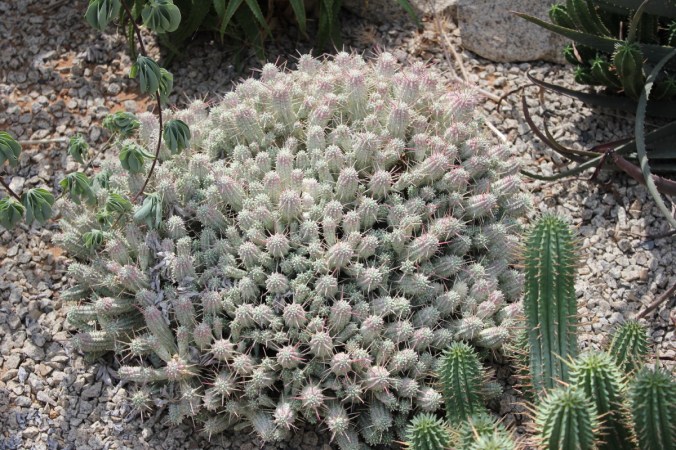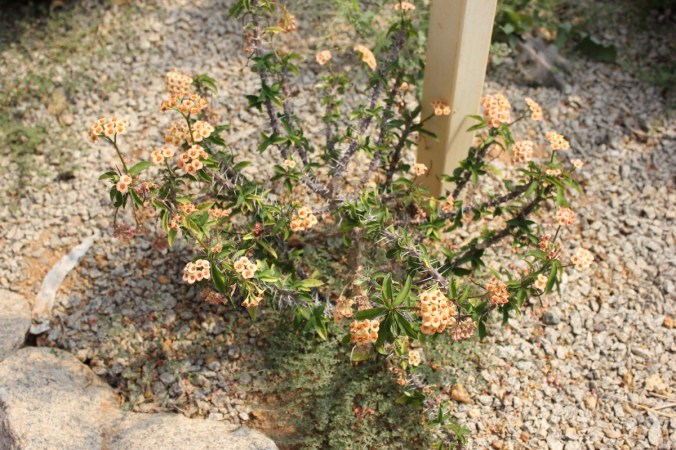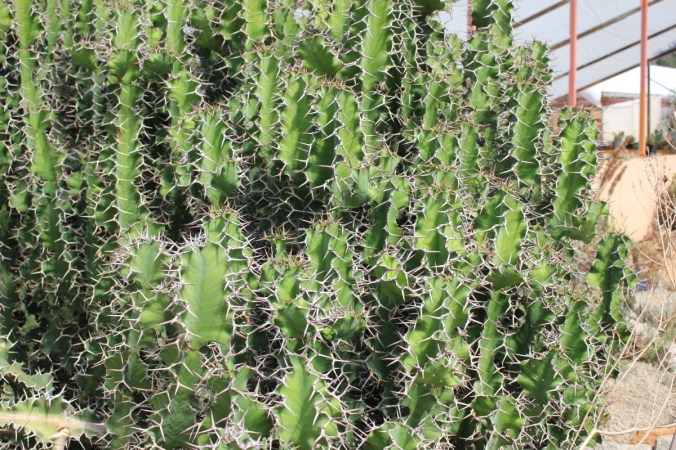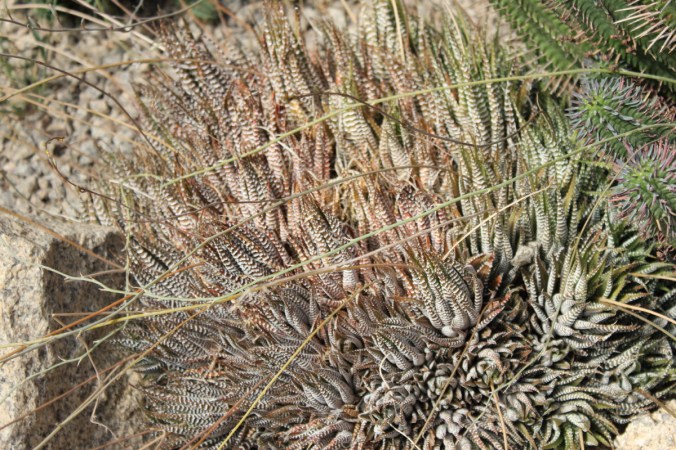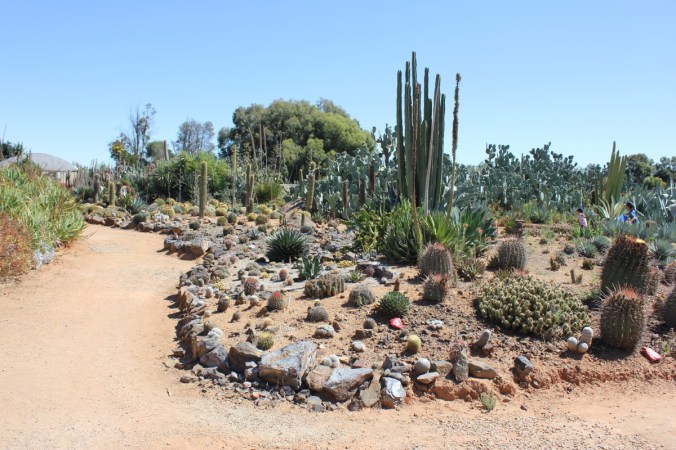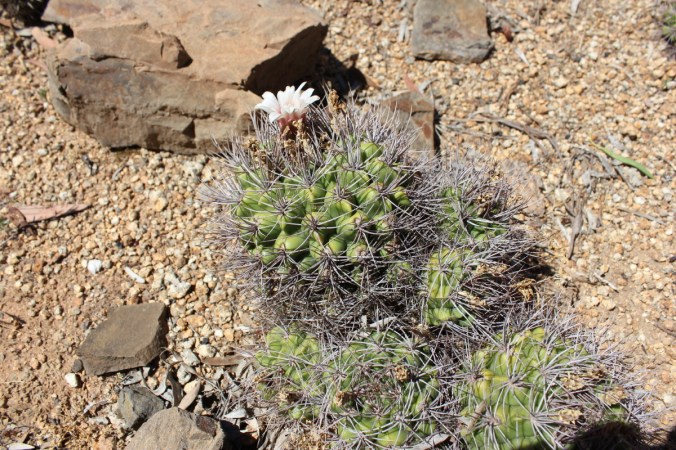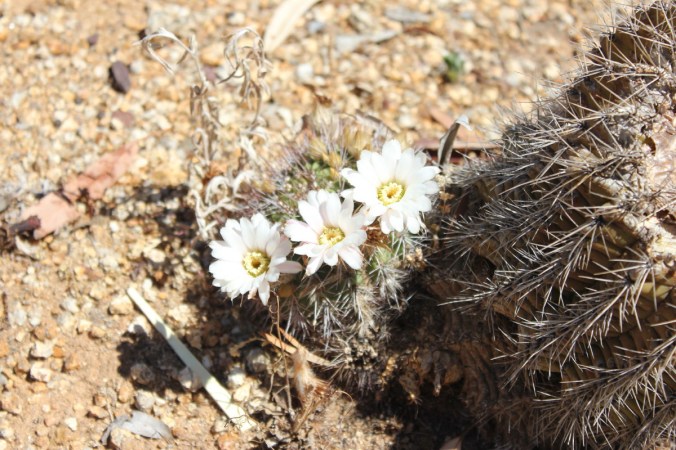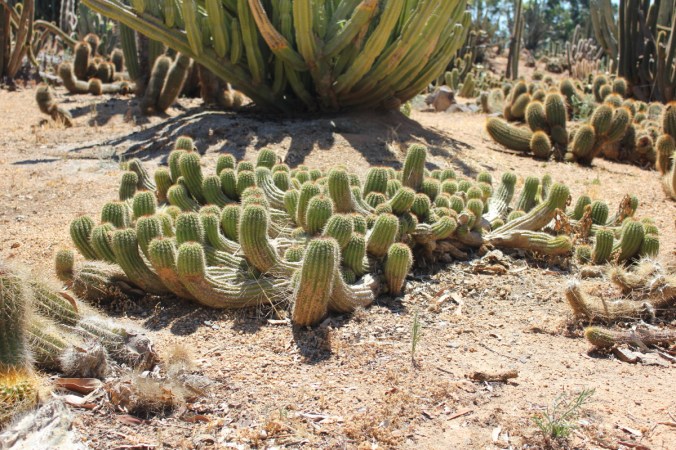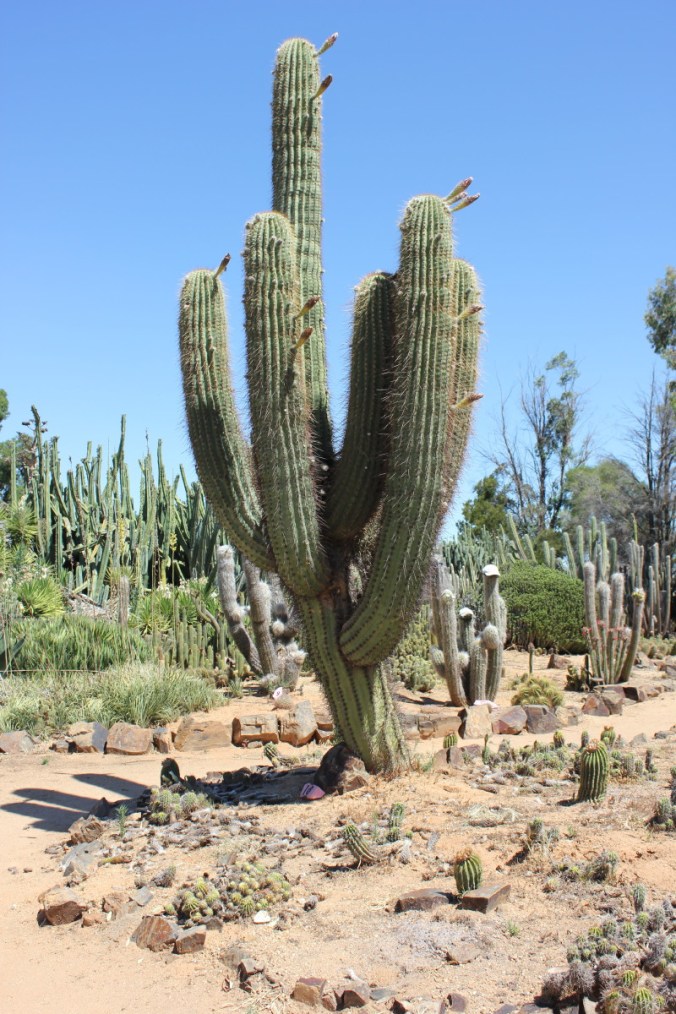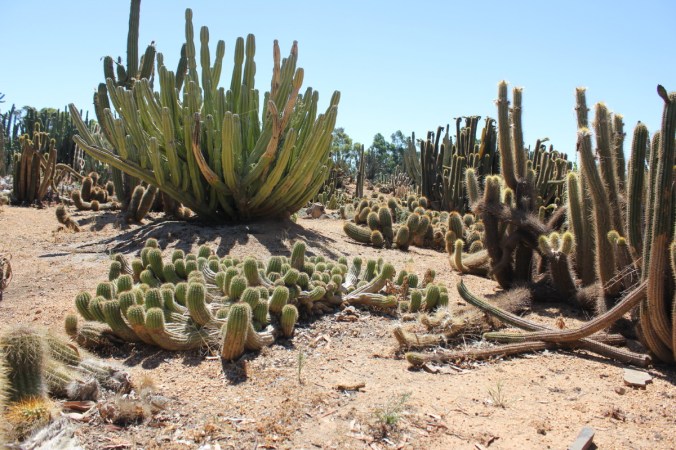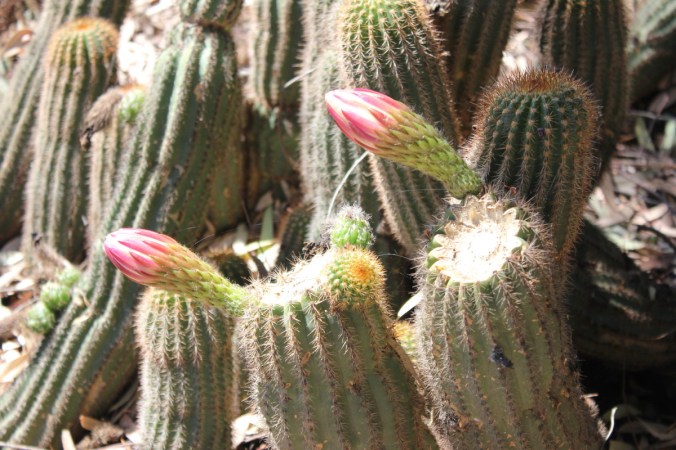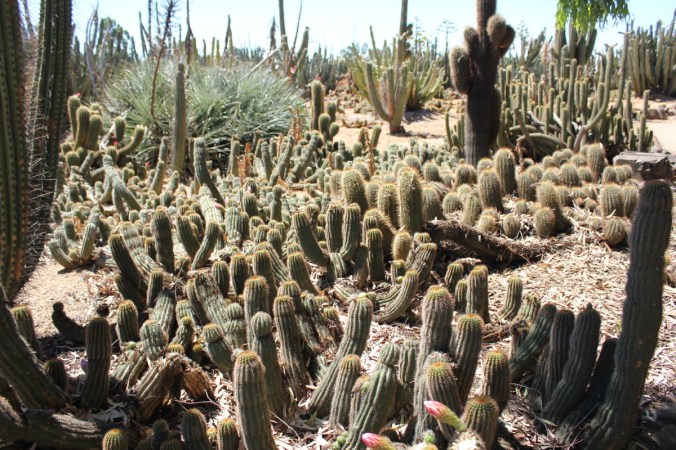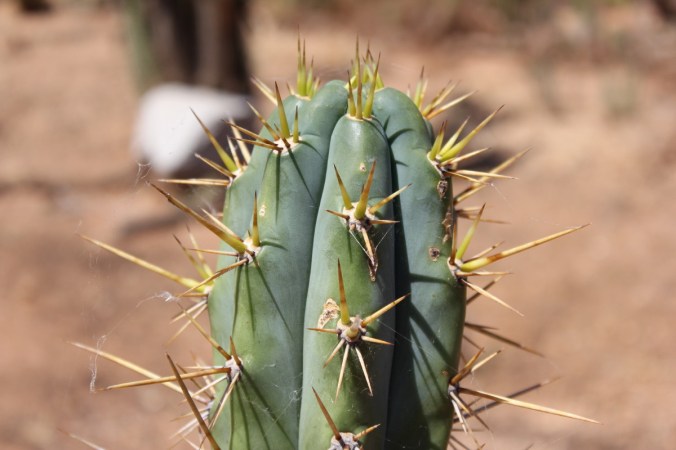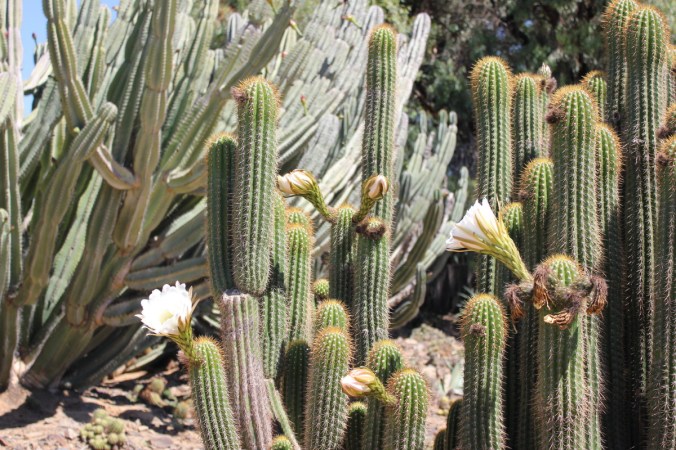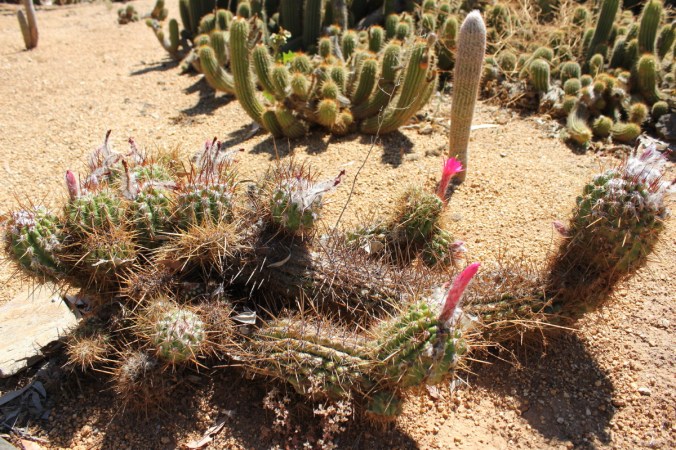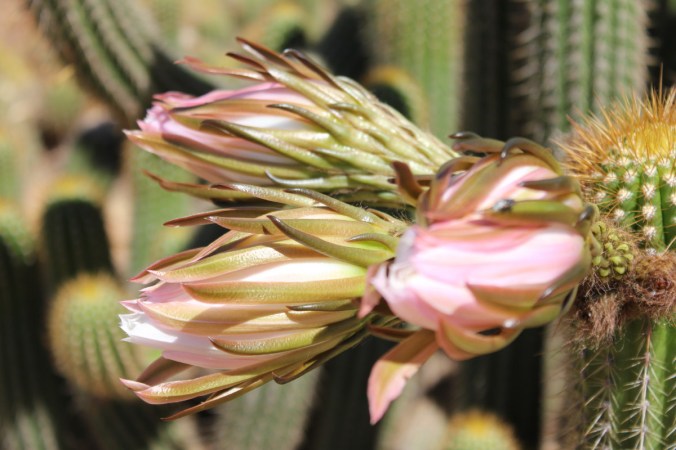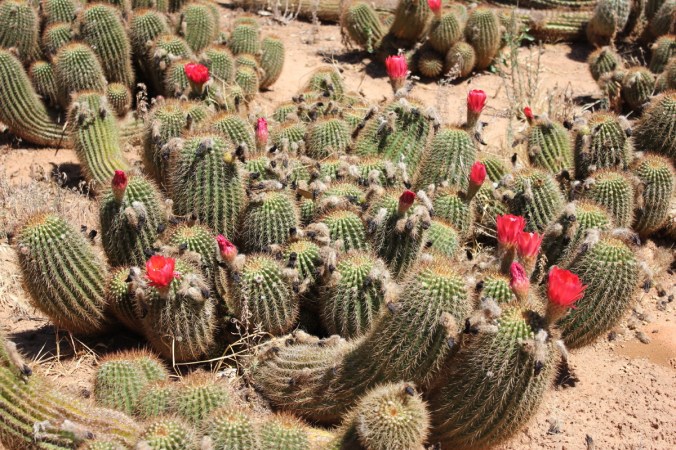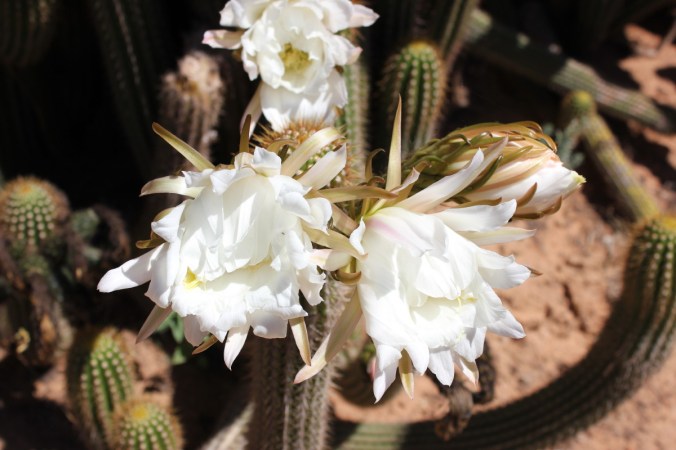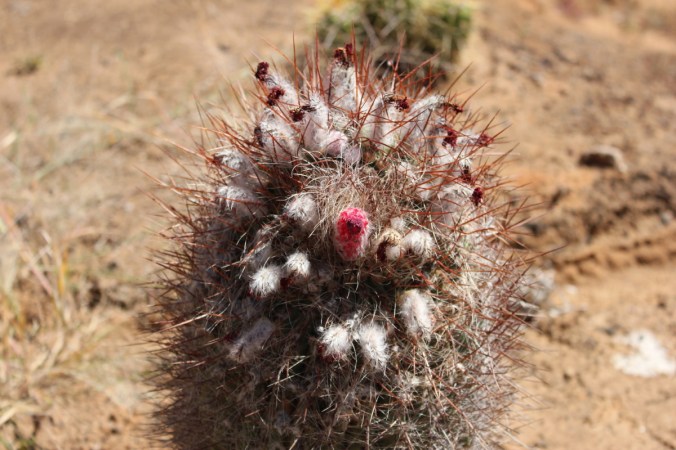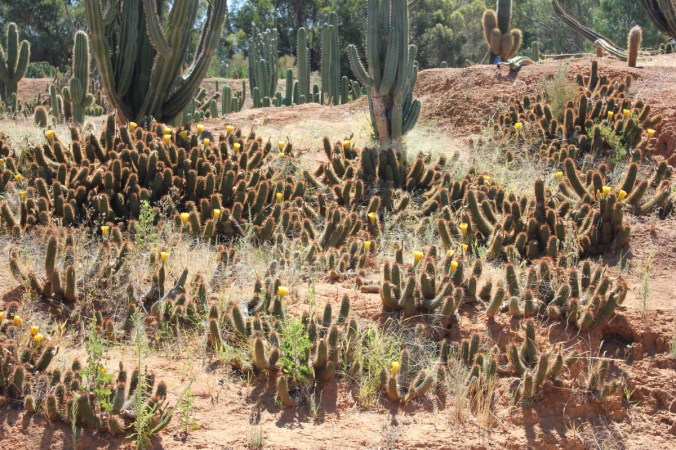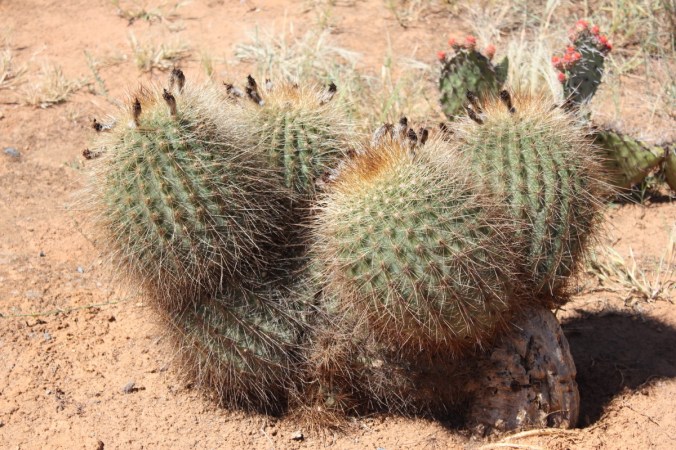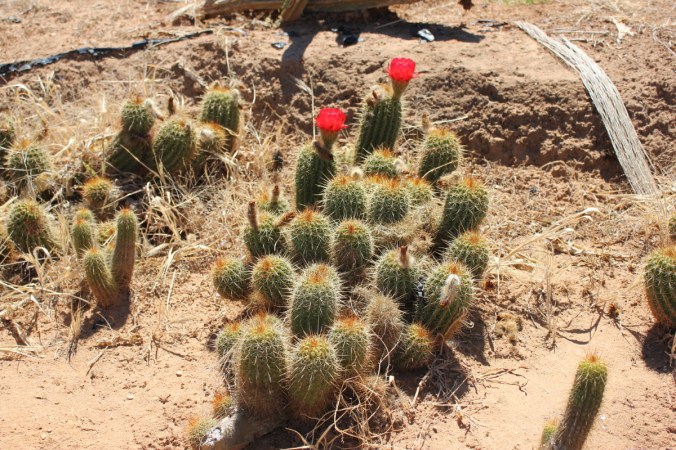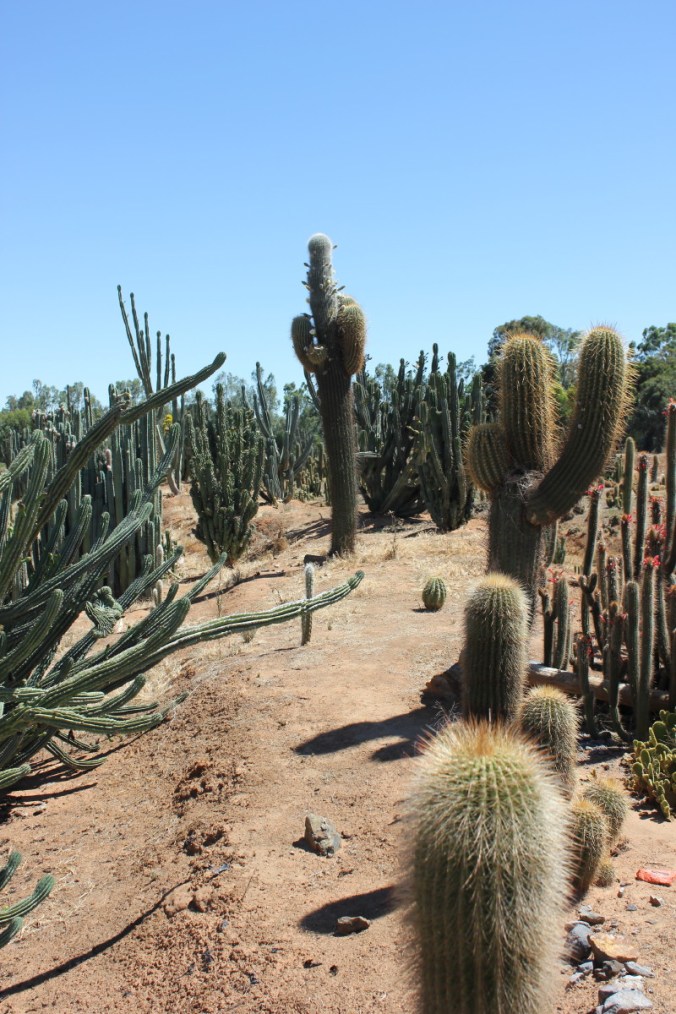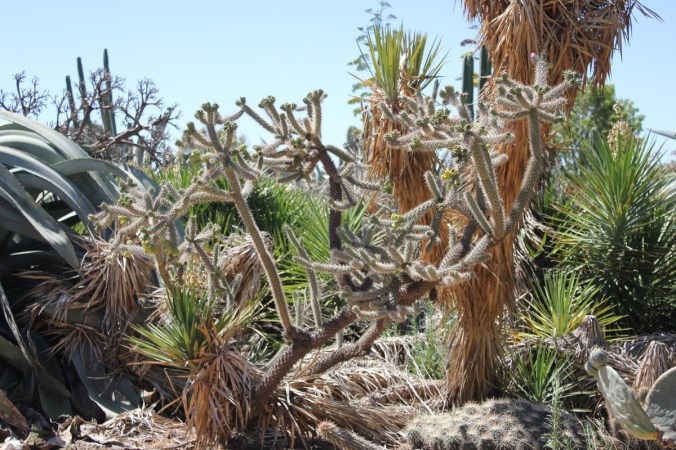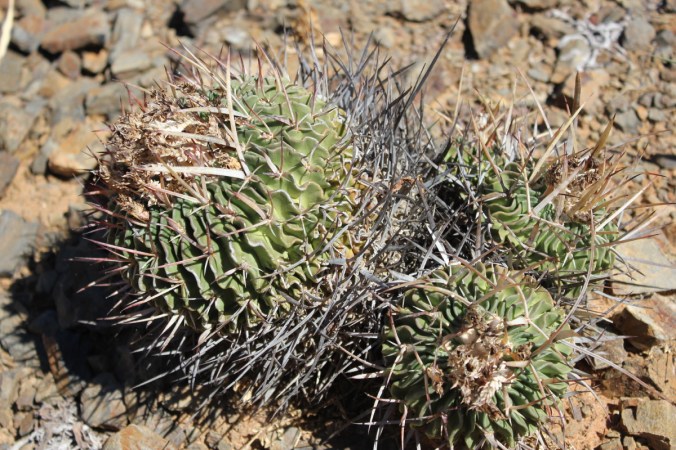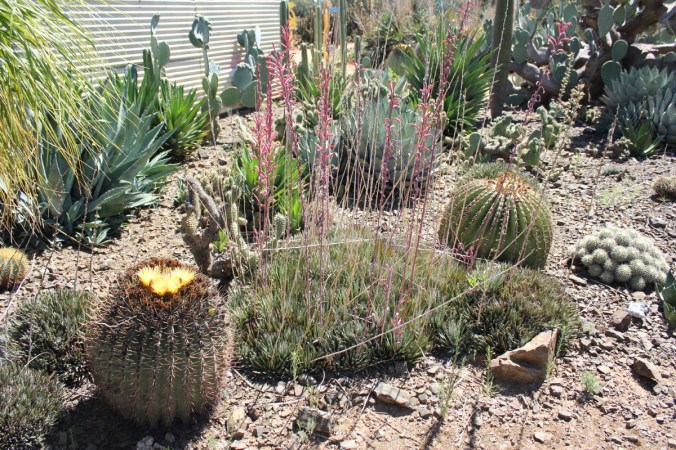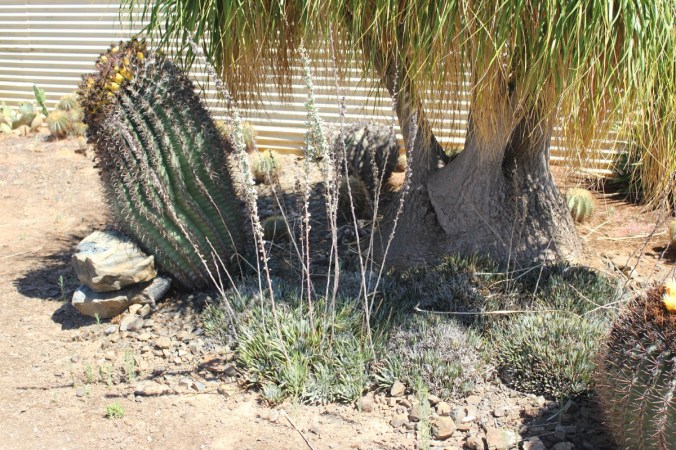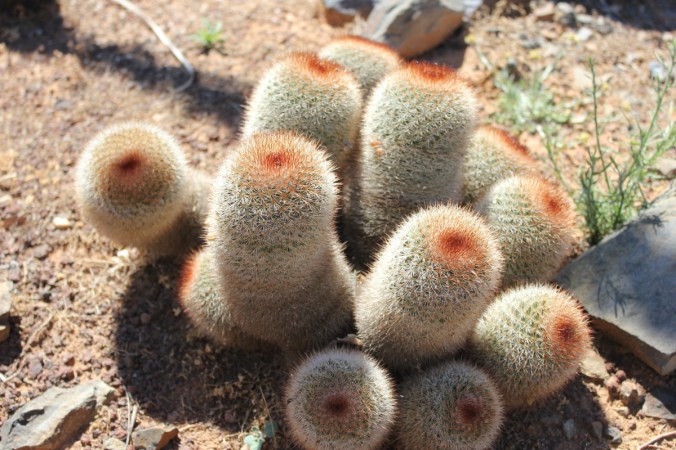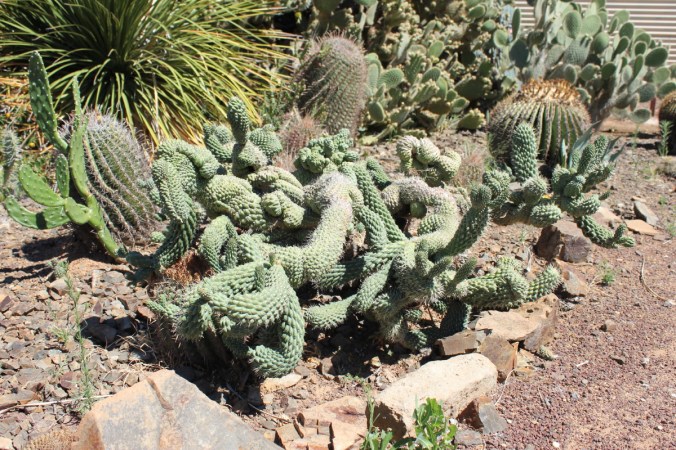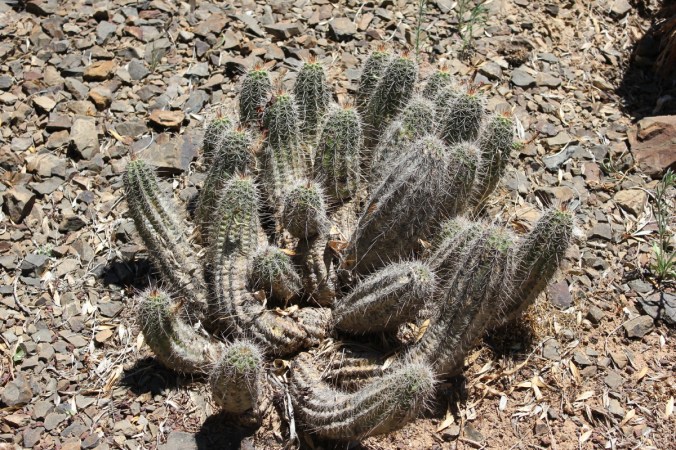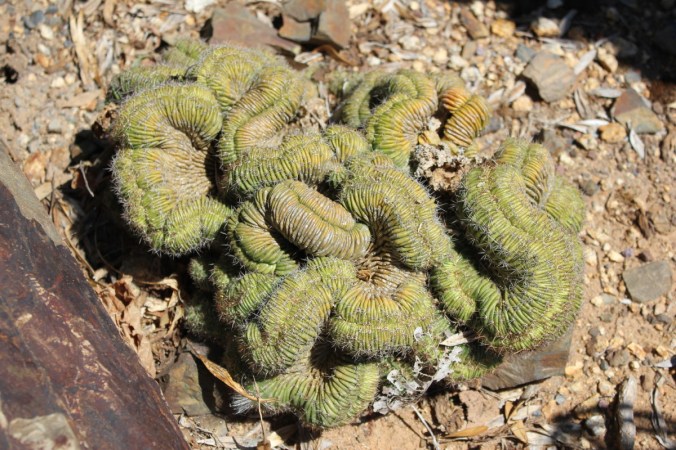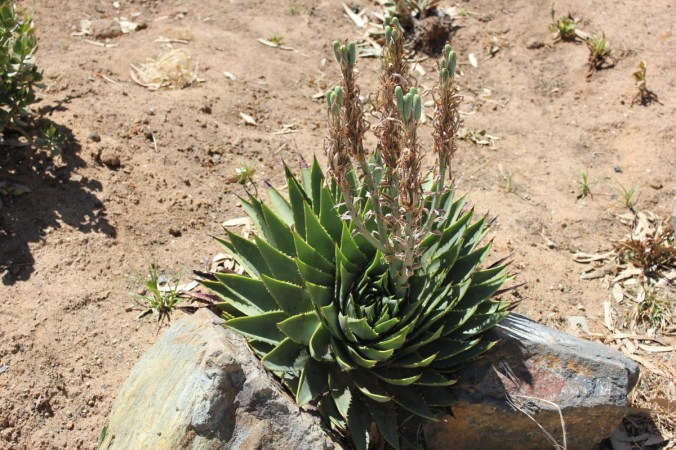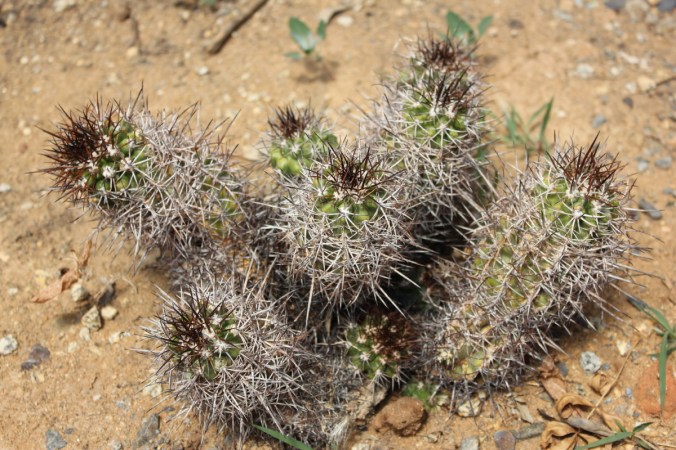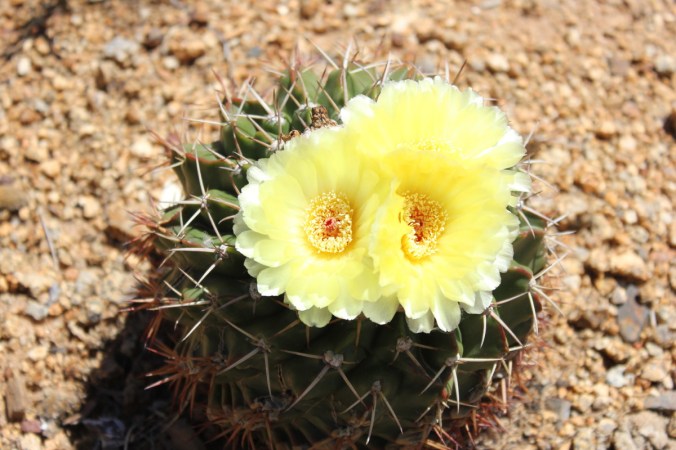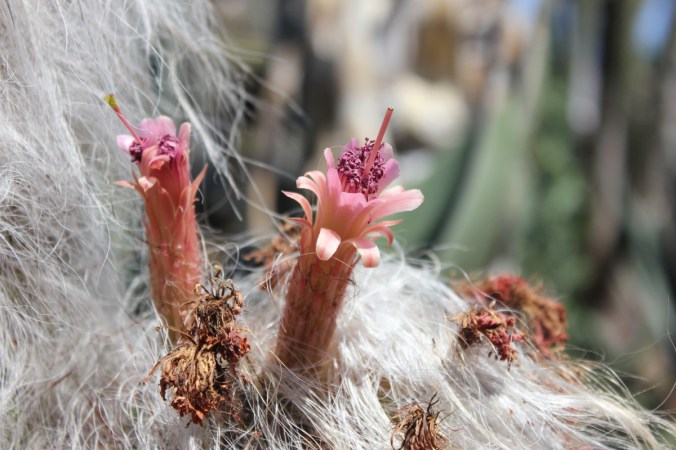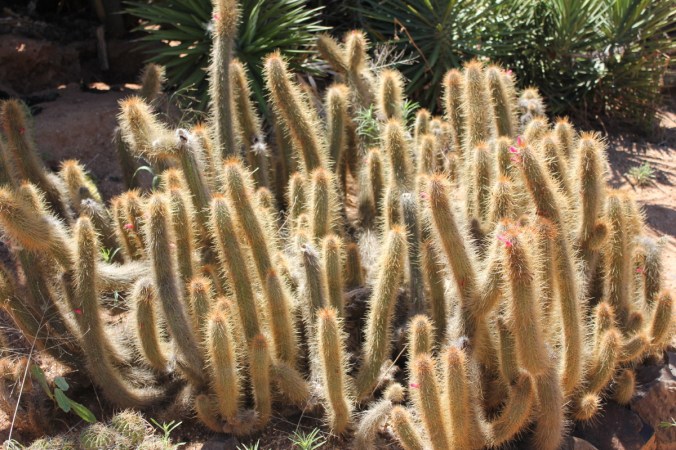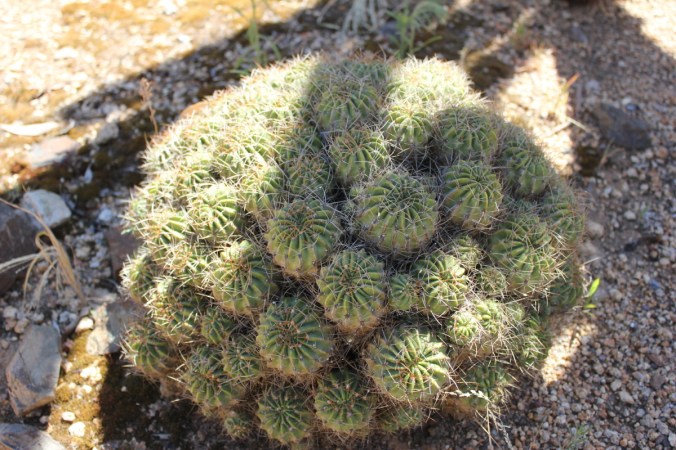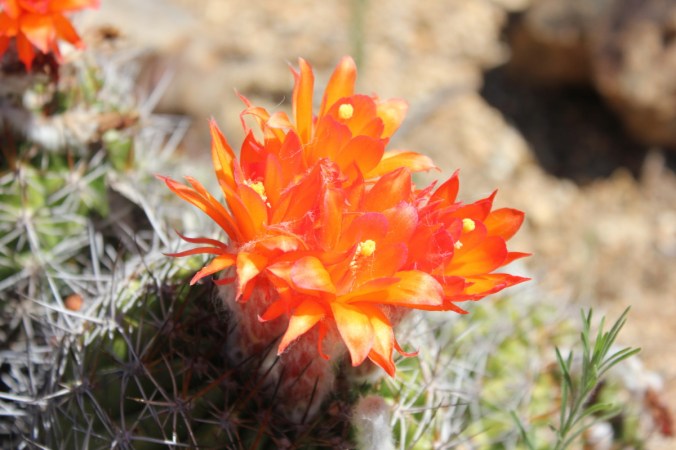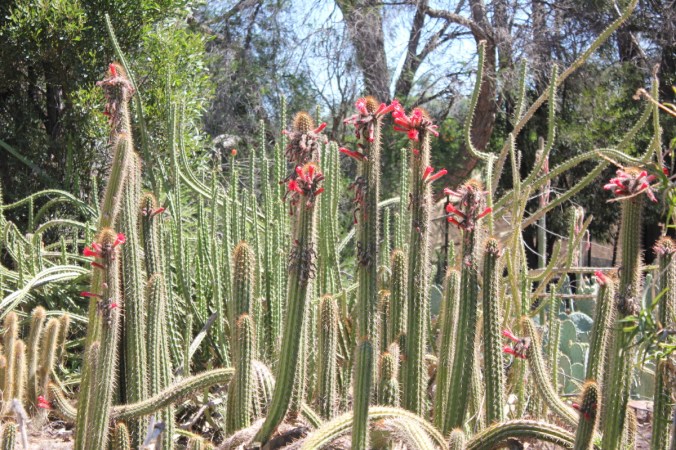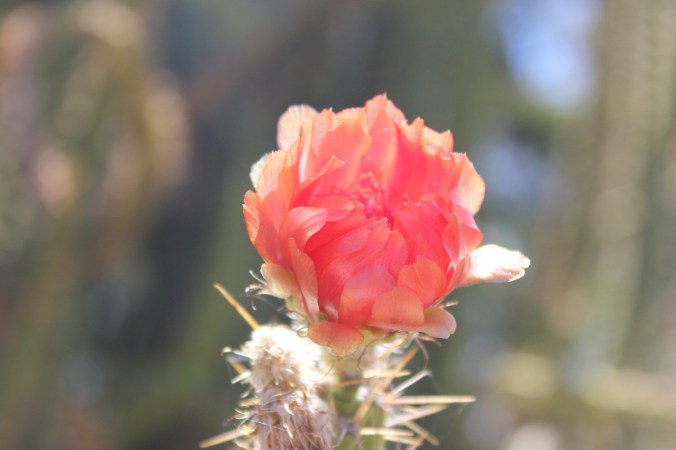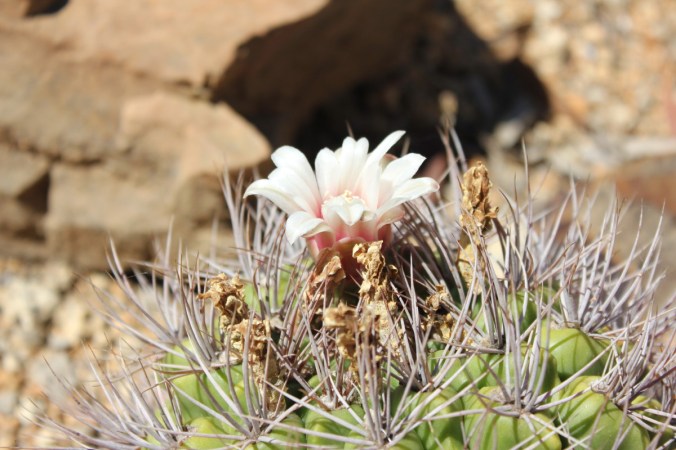Macdonnell Ranges-Serpentine Gorge
Hi there!
Heading west out of Alice Springs on Namatjira drive you are soon in the heart of the Macdonnell Ranges. We went past places like, Standley Chasm, Simpsons Gap, Ellery Creek Water Hole and then we pulled up at Serpentine Gorge. All these places by the way are easily accessible from Alice Springs as Day trips, quite handy if you don’t want to camp out in the wilds! The Macdonnell Ranges run for about 640 odd km’s east and west of Alice Springs. Parallel ridges on either side of the valley are quite visible and in these ridges there are gaps which provide spectacular scenery and beautiful waterholes to cool of in the middle of summer. The Ranges were green from recent rain which really made them standout amongst the surrounding landscape of red and ochre desert colours. If you want to learn more about the Macdonnell ranges click HERE.
Serpentine Gorge was created by a south flowing creek which has cut through two ridges of Heavitree Quartzite leaving a spectacular gorge. The road in is not too bad for a dirt road and once you get to the parking area it’s about a 1.5km walk in to the gorge across dry creek beds and scrubland. If you’re lucky and are here after rain there are lots of wildflowers to see. I was the one lagging behind taking photos of plants and flowers as the rest of the family steamed ahead to the heady heights of the gorge lookout. Now if you want to see pictures of Serpentine Gorge in all its glory, I’m not going to show them right now! You will need to scroll through this post to find them, cruel I know but well worth it!
Here is one of the dry creek beds, very rocky as you can see.
 This is what a lot of the surrounding plant scape looks like, uninspiring you may say but you just need to look closely to find its beauty.
This is what a lot of the surrounding plant scape looks like, uninspiring you may say but you just need to look closely to find its beauty.
 Larapinta trail marker, this walking trail is 223km in length across the Macdonnell ranges, click on this link, maybe one day!
Larapinta trail marker, this walking trail is 223km in length across the Macdonnell ranges, click on this link, maybe one day!

If you’re walking too fast you will miss this little plant. Brachyscome ciliaris also known as Variable Daisy is found in all states of Australia and usually in sand and gibber plains(extended plain with loose rocks). Grows to about 45cm. Brachyscome quite often seen in nurseries and gardens around the country even more exciting to find it out here!
 Remember! Don’t just look ahead, cast your eye’s down and to the sides of where you’re walking, you’ll never know what you will find or see next.
Remember! Don’t just look ahead, cast your eye’s down and to the sides of where you’re walking, you’ll never know what you will find or see next.


Above is a couple of more photos of this little gem. Now, what about some Nightshade! Solanum quadriloculatum. That’s a mouthful, Wild Tomato sound better? Be very wary, this plants fruit are poisonous, another reason why common names are misleading. This plant grows to 50 x 50cm near flooded watercourses and or low sand dunes. It’s quite prickly and flowers in winter and spring.
 Below is Senna artemisoides subsp. artemisoides, another mouthful but a very beautiful shrub which grows to about 1-2 metres with beautiful yellow buttercup flowers in winter and spring.
Below is Senna artemisoides subsp. artemisoides, another mouthful but a very beautiful shrub which grows to about 1-2 metres with beautiful yellow buttercup flowers in winter and spring.
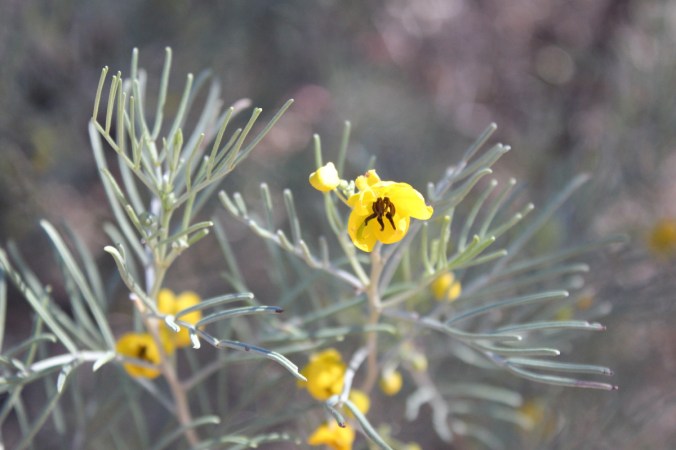
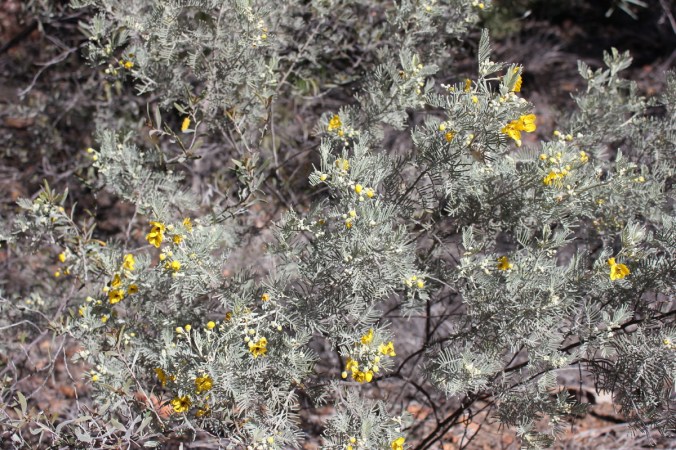 Maybe you can just call it the Silver Cassia. Now for an Emu Bush. Eremophila latrobei , commonly known as the Crimson Turkeybush, click HERE if you want to read more about this plant. Quite beautiful!
Maybe you can just call it the Silver Cassia. Now for an Emu Bush. Eremophila latrobei , commonly known as the Crimson Turkeybush, click HERE if you want to read more about this plant. Quite beautiful!

 Another stunning Emu bush is Eremophila longifolia , also known as Berrigan, tall shrub to small tree weeping in form, click HERE if you want to know more about the Berrigan.
Another stunning Emu bush is Eremophila longifolia , also known as Berrigan, tall shrub to small tree weeping in form, click HERE if you want to know more about the Berrigan.
 Sorry, I got distracted with the plants in the Serpentine Gorge, lets move onto the scenery. This is the first sort of glimpse of the gorge and it looks like its sort of straight up to the top, hmm!
Sorry, I got distracted with the plants in the Serpentine Gorge, lets move onto the scenery. This is the first sort of glimpse of the gorge and it looks like its sort of straight up to the top, hmm!
 Lets go for it! Now we are starting the climb up and here you can clearly see the parallel ridge lines that run through the Macdonnell Ranges.
Lets go for it! Now we are starting the climb up and here you can clearly see the parallel ridge lines that run through the Macdonnell Ranges.
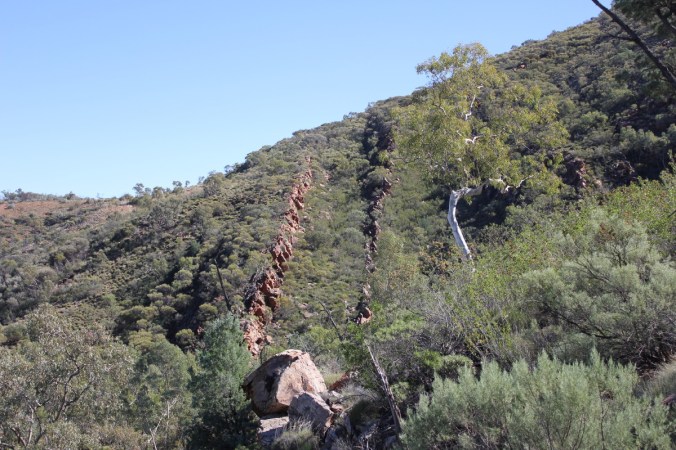 Another couple of views of those ridge lines
Another couple of views of those ridge lines
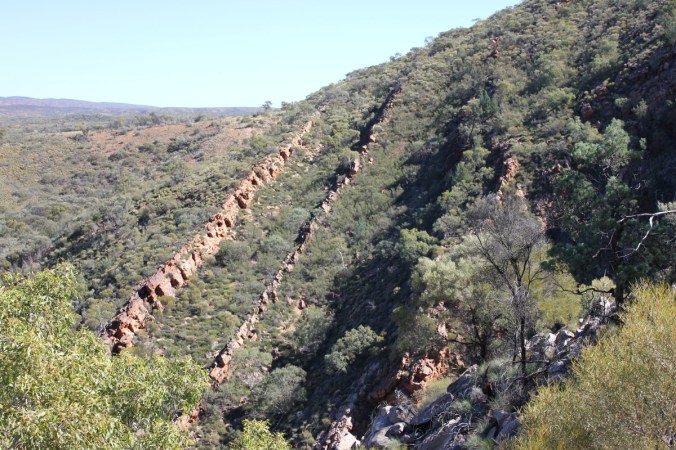
 Yes, as you can see above we are getting higher, quite spectacular! It is quite a rocky landscape and on these hillsides there is a lot of Porcupine grass, Trioda irritans. The last past of its botanic name sums it up very well indeed, very irritating because it’s quite prickly.
Yes, as you can see above we are getting higher, quite spectacular! It is quite a rocky landscape and on these hillsides there is a lot of Porcupine grass, Trioda irritans. The last past of its botanic name sums it up very well indeed, very irritating because it’s quite prickly.

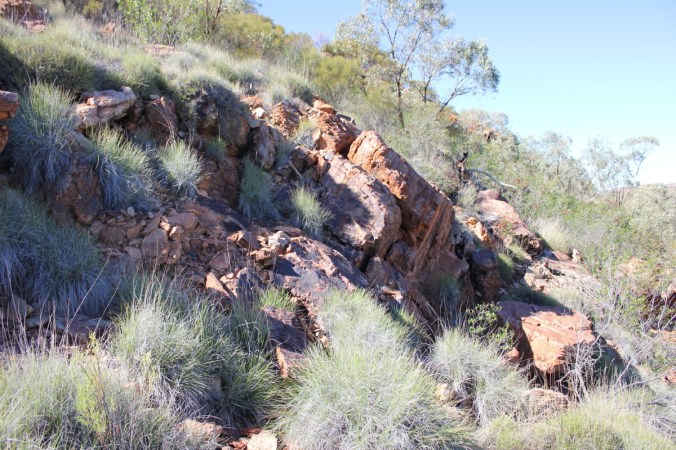 Below are more views across the valley.
Below are more views across the valley.

 Another plant of interest for me to see in the wild was Dodonaea viscosa , the Broad leaf Hop Bush or just plain Hop Bush, very common in gardens around the country and useful for many things from hedging to specimen plantings. It’s a very variable plant in the wild and widespread across the country.
Another plant of interest for me to see in the wild was Dodonaea viscosa , the Broad leaf Hop Bush or just plain Hop Bush, very common in gardens around the country and useful for many things from hedging to specimen plantings. It’s a very variable plant in the wild and widespread across the country.

 Now I know photos are great but there’s just no comparison to actually being there and seeing this landscape. I have a great digital SLR camera but it doesn’t capture the WOW! The size, scope and detail of what your eyes are looking at or what your feeling right then and there as you look at this amazing country. Below is the Serpentine Gorge.
Now I know photos are great but there’s just no comparison to actually being there and seeing this landscape. I have a great digital SLR camera but it doesn’t capture the WOW! The size, scope and detail of what your eyes are looking at or what your feeling right then and there as you look at this amazing country. Below is the Serpentine Gorge.



 Where does one go now from these heights? Down one would expect and lo and behold something I missed on the way up nearly hit me fair and square in the head on the way down.
Where does one go now from these heights? Down one would expect and lo and behold something I missed on the way up nearly hit me fair and square in the head on the way down.
 Leaning over the rocky pathway was this intriguing large shrub with what looked like stems twining around themselves like a climbing plant. This is Pandorea doratoxylon also known as the Spearwood Vine. The Aboriginal people use this plant for spears hence its common name. The long twining stems are light weight and are straightened and hardened over a fire. The flowers are quite pretty when one comes upon them in such a tough landscape.
Leaning over the rocky pathway was this intriguing large shrub with what looked like stems twining around themselves like a climbing plant. This is Pandorea doratoxylon also known as the Spearwood Vine. The Aboriginal people use this plant for spears hence its common name. The long twining stems are light weight and are straightened and hardened over a fire. The flowers are quite pretty when one comes upon them in such a tough landscape.
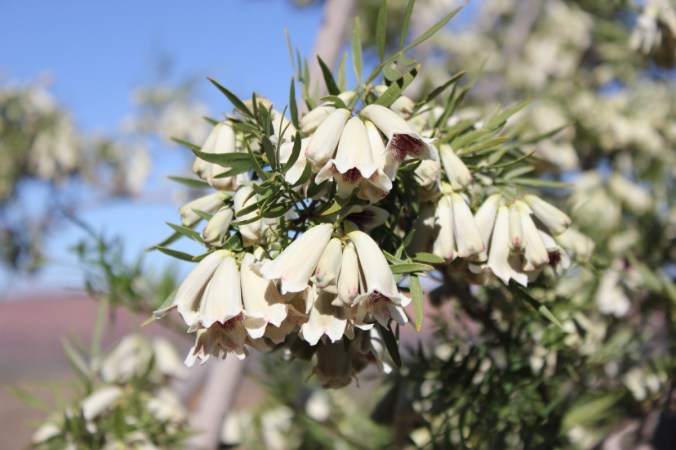 If they look familiar to you, you may be thinking of Pandorea jasminoides the Wonga Wonga vine or also known as the Bower Vine or one of the many hybrids available today. You would be correct because they are in the same family Bignoniaceae. Check out this closeup below!
If they look familiar to you, you may be thinking of Pandorea jasminoides the Wonga Wonga vine or also known as the Bower Vine or one of the many hybrids available today. You would be correct because they are in the same family Bignoniaceae. Check out this closeup below!
 This next photo doesn’t show too much, I just liked the detail of the bark. To me it tells a story of the harsh landscape in which it resides.
This next photo doesn’t show too much, I just liked the detail of the bark. To me it tells a story of the harsh landscape in which it resides.
 These next photos show an interesting Grevillea, the Holly Leaf Grevillea, Grevillea wickhamii. There are a few sub species but I’m not sure which one this is. I have pictures of this flowering at a different location which will be revealed at a later date!
These next photos show an interesting Grevillea, the Holly Leaf Grevillea, Grevillea wickhamii. There are a few sub species but I’m not sure which one this is. I have pictures of this flowering at a different location which will be revealed at a later date!

 You can see above that the new growth gives the plant a tinge of yellow which from a distance look like flowers.
You can see above that the new growth gives the plant a tinge of yellow which from a distance look like flowers.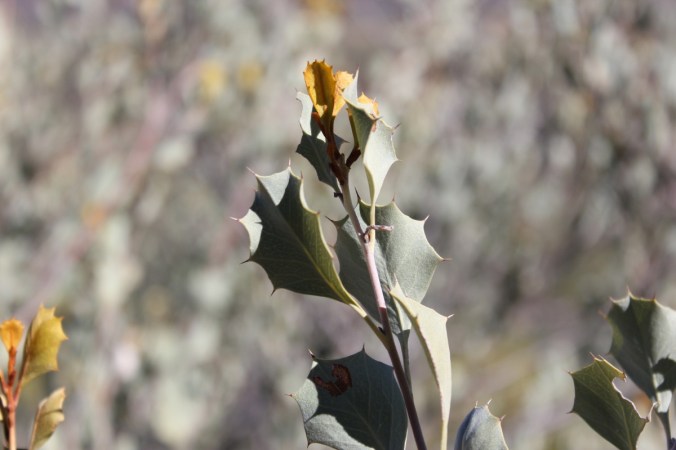 Some more plants of interest here included another beautiful Emu Bush, Eremophila freelingii. The Rock Fuchsia Bush.
Some more plants of interest here included another beautiful Emu Bush, Eremophila freelingii. The Rock Fuchsia Bush.

 A characteristic of this plant is that it sheds its lower leaves during drought to conserve moisture, you can see that quite clearly in the above photo, the plant looks half dead but it’s not! Grows to about 1.5 metres. The lilac flowers are stunning and are produced after it rains. Just a few more views below of this beautiful plant on the sides of Serpentine Gorge.
A characteristic of this plant is that it sheds its lower leaves during drought to conserve moisture, you can see that quite clearly in the above photo, the plant looks half dead but it’s not! Grows to about 1.5 metres. The lilac flowers are stunning and are produced after it rains. Just a few more views below of this beautiful plant on the sides of Serpentine Gorge.


 Funnily enough another surprise was what looked to be some type of Fern here as well and yes it was. Not sure of its identity but quite possibly Cheilanthes brownie , The Northern Rock Fern, either way still remarkable to me to see a fern out here. Nature is amazing.
Funnily enough another surprise was what looked to be some type of Fern here as well and yes it was. Not sure of its identity but quite possibly Cheilanthes brownie , The Northern Rock Fern, either way still remarkable to me to see a fern out here. Nature is amazing.

 Another interesting plant we saw was a parasite. Lysiana exocarpi , the Harlequin Mistletoe. This parasite is found mostly in inland locations and is very colourful.
Another interesting plant we saw was a parasite. Lysiana exocarpi , the Harlequin Mistletoe. This parasite is found mostly in inland locations and is very colourful.

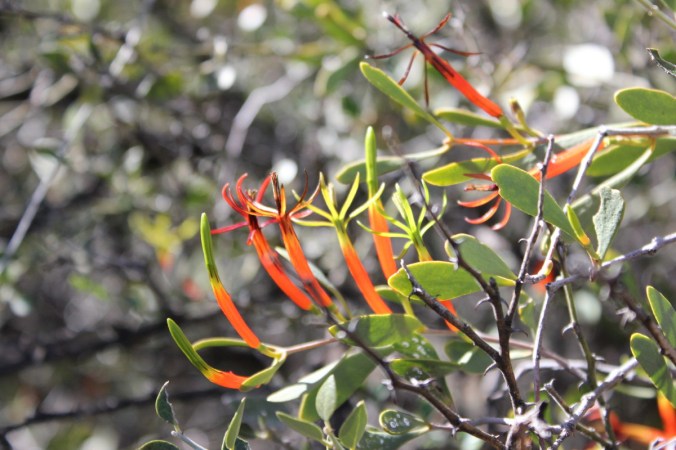 Now we have made it back down and headed into the cool of the gorge, being winter it wasn’t hot out in the open so one could imagine how nice and cool it would be in the heat of summer.
Now we have made it back down and headed into the cool of the gorge, being winter it wasn’t hot out in the open so one could imagine how nice and cool it would be in the heat of summer.
 In the above photo in the distance you can see some cycads, Macrozamia macdonnellii , the Macdonnell Ranges Cycad. Here they are below as well.
In the above photo in the distance you can see some cycads, Macrozamia macdonnellii , the Macdonnell Ranges Cycad. Here they are below as well.
 Ah well! That’s about it for the Serpentine Gorge, here’s a few last photos of plants and foliage.
Ah well! That’s about it for the Serpentine Gorge, here’s a few last photos of plants and foliage.
Lets have some lunch, its been a great morning in the Macdonnell Ranges. Serpentine Gorge has been a truly magical experience.
 Finally a last look into the gorge.
Finally a last look into the gorge.













 Cheers!
Cheers! Yes it is empty, this is only some puddles that are not moving.
Yes it is empty, this is only some puddles that are not moving. Some of the kids having a ball in the puddles.
Some of the kids having a ball in the puddles.

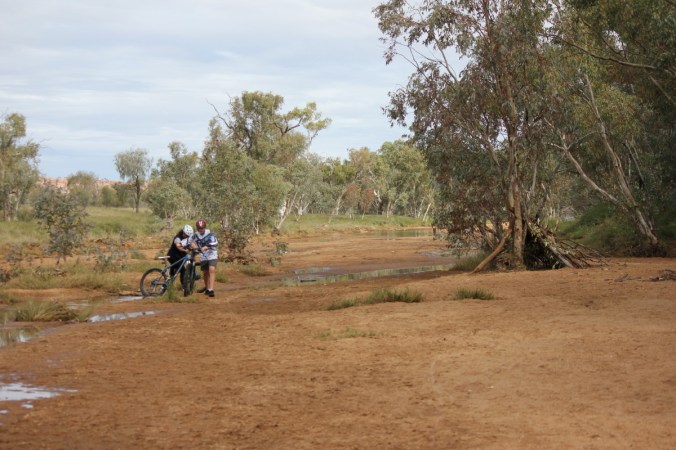 Here’s the dingo stalking a galah…..
Here’s the dingo stalking a galah…..

 Missed it.. ah well, there’s always next time.
Missed it.. ah well, there’s always next time.



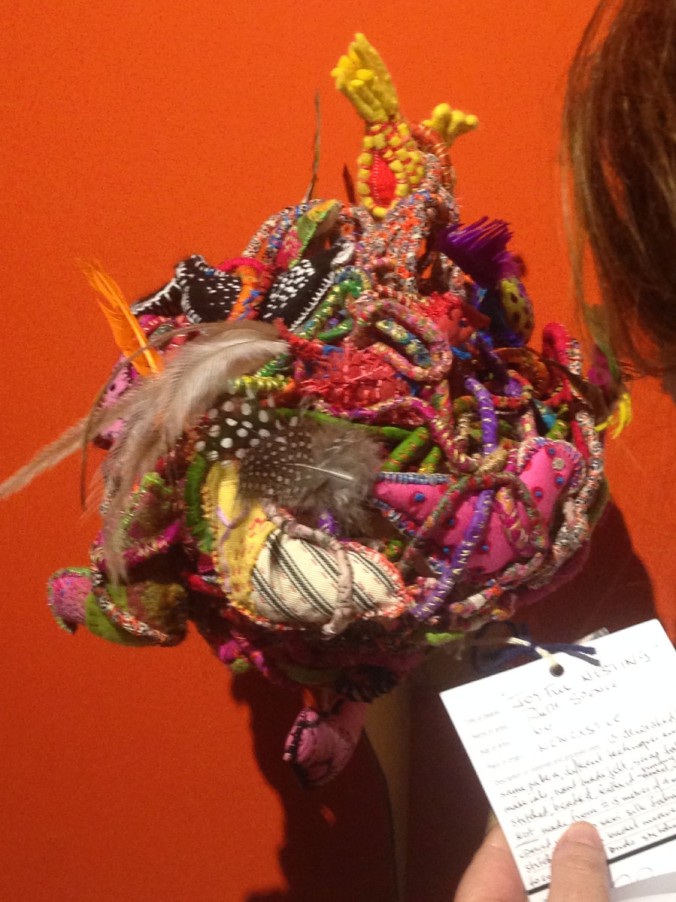


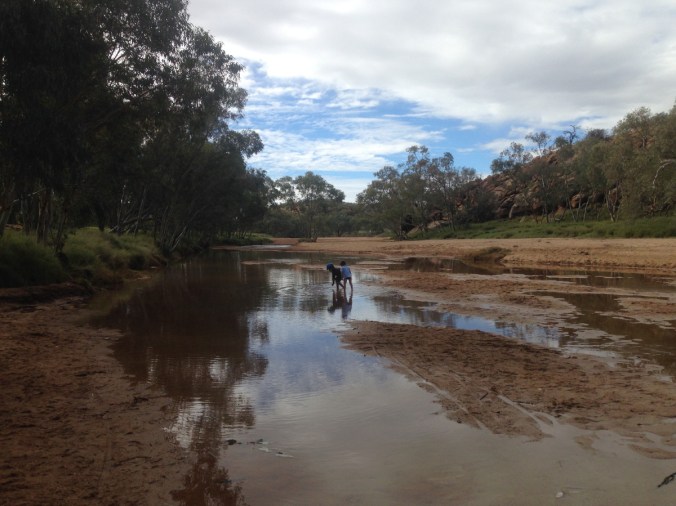


 Well maybe just a smidgen of water. The parting shot of Alice Springs for this post is from Anzac Hill. A memorial to the
Well maybe just a smidgen of water. The parting shot of Alice Springs for this post is from Anzac Hill. A memorial to the 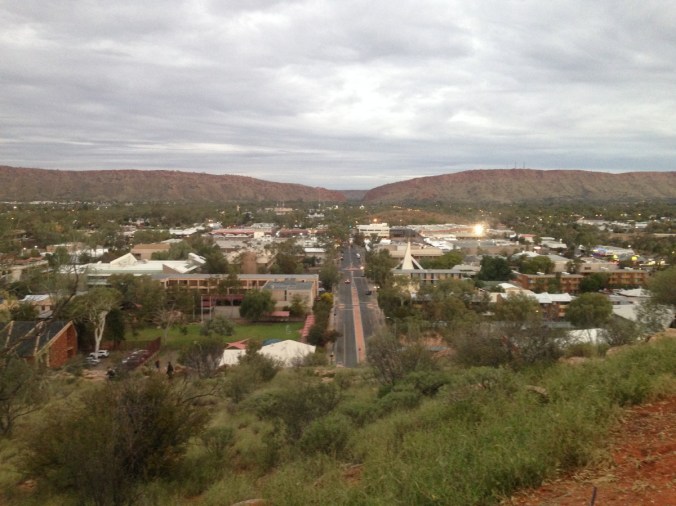

 Thanks “ALICE” it was a blast!!
Thanks “ALICE” it was a blast!!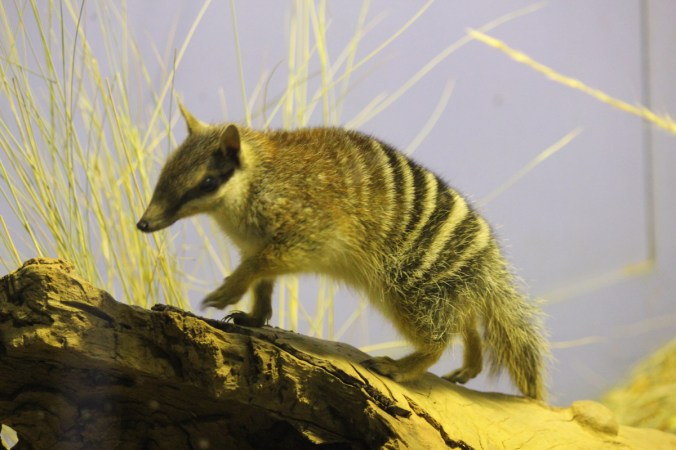
 Of course there were all sorts of snakes and lizards, sorry about the blurry picture but I just had to include this nasty looking fellow!
Of course there were all sorts of snakes and lizards, sorry about the blurry picture but I just had to include this nasty looking fellow! The Thorny devils are always great to watch, these fellows were standing there and eating the ants as they went past them. Their tongues would just flick out and snaffle them up.
The Thorny devils are always great to watch, these fellows were standing there and eating the ants as they went past them. Their tongues would just flick out and snaffle them up.



 As you can see they are certainly thorny, also very well camouflaged for the desert environment. The Lizard below is just hanging out, I don’t know his name.
As you can see they are certainly thorny, also very well camouflaged for the desert environment. The Lizard below is just hanging out, I don’t know his name.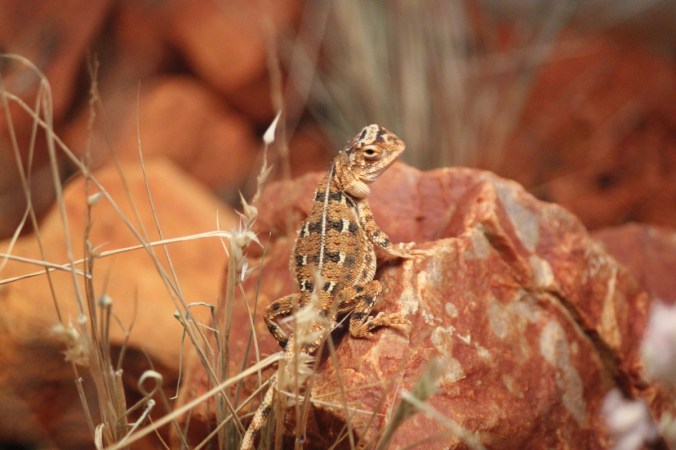 What I noticed a lot of in the park were lots of different Erimophila shrubs. There are about 260 Erimophila species endemic to Australia, also known as Emu Bushes. There are also many cultivars available in nurseries now. Here’s a few from the Desert Park.
What I noticed a lot of in the park were lots of different Erimophila shrubs. There are about 260 Erimophila species endemic to Australia, also known as Emu Bushes. There are also many cultivars available in nurseries now. Here’s a few from the Desert Park.




 If I say Dingo, what is the first thing that pops into your mind? If you come from Australia like me, I would haphazard a guess that the name
If I say Dingo, what is the first thing that pops into your mind? If you come from Australia like me, I would haphazard a guess that the name 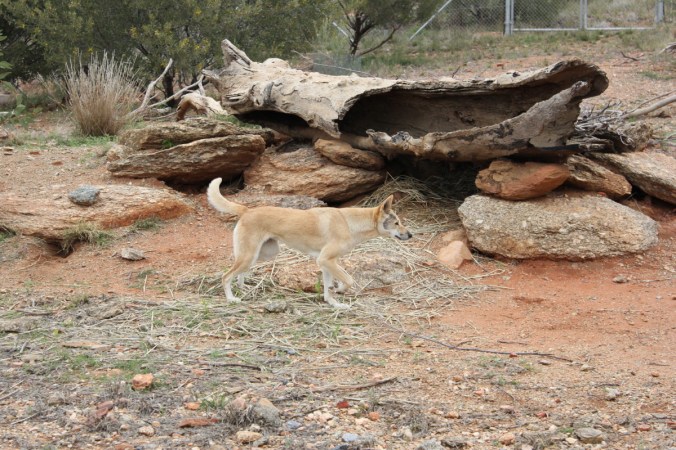
 They blend in quite beautifully with their surroundings as you can see. They also come with different coat colours depending on what habitat they live in. Interesting!
They blend in quite beautifully with their surroundings as you can see. They also come with different coat colours depending on what habitat they live in. Interesting! Here’s another plant that’s prominent in the Alice Springs area Senna artemisiodes subsp. oligophylla, also known as Oval Leaf Cassia. A beautiful yellow flowering shrub to 2 metres.
Here’s another plant that’s prominent in the Alice Springs area Senna artemisiodes subsp. oligophylla, also known as Oval Leaf Cassia. A beautiful yellow flowering shrub to 2 metres.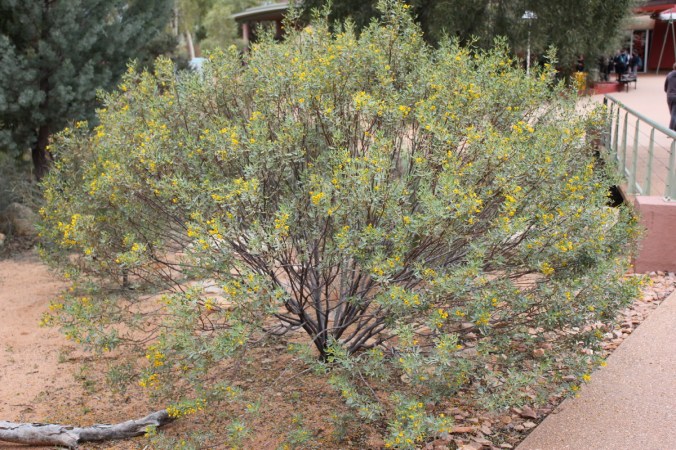

 Another very exciting exhibit at the Alice Springs Desert Park is the Birds of Prey demonstration. Keep your head low!! A couple of Kites put on quite a masterful aerial display.
Another very exciting exhibit at the Alice Springs Desert Park is the Birds of Prey demonstration. Keep your head low!! A couple of Kites put on quite a masterful aerial display.


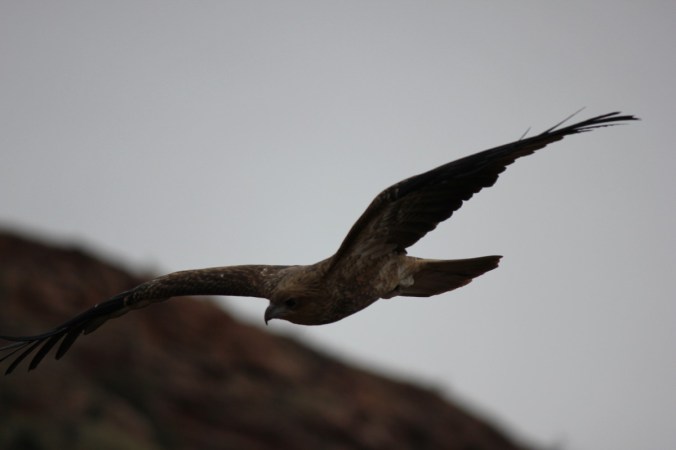
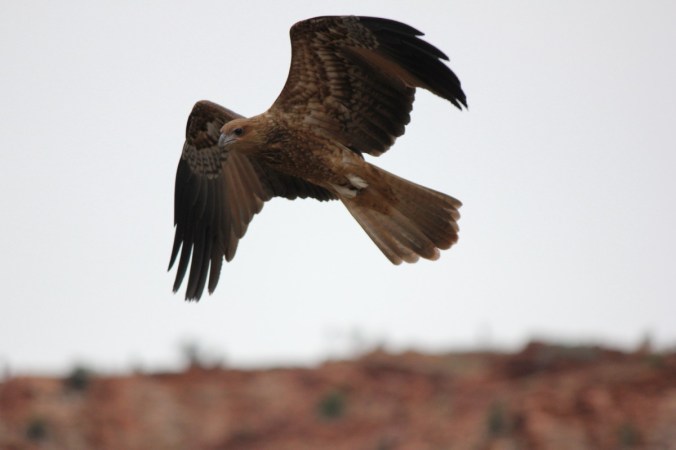


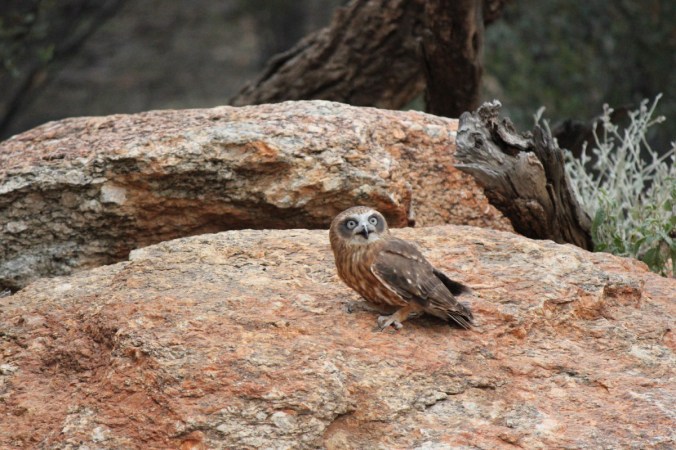


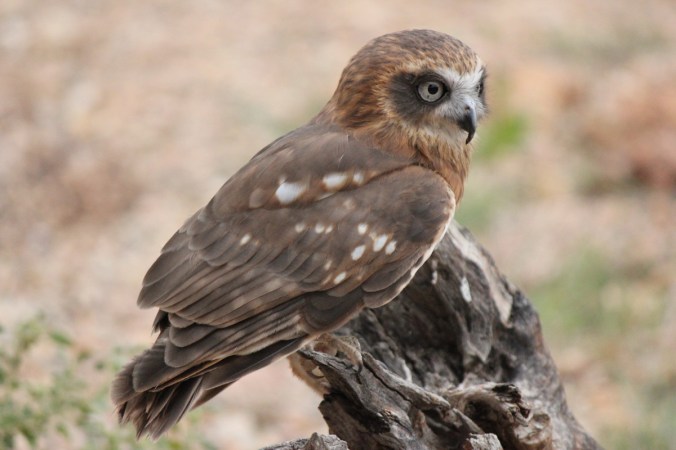 Of course the star of the show is the mighty Wedge Tail Eagle. These are quite widespread across the country and we see lots at home but still they are impressive wherever you see them.
Of course the star of the show is the mighty Wedge Tail Eagle. These are quite widespread across the country and we see lots at home but still they are impressive wherever you see them.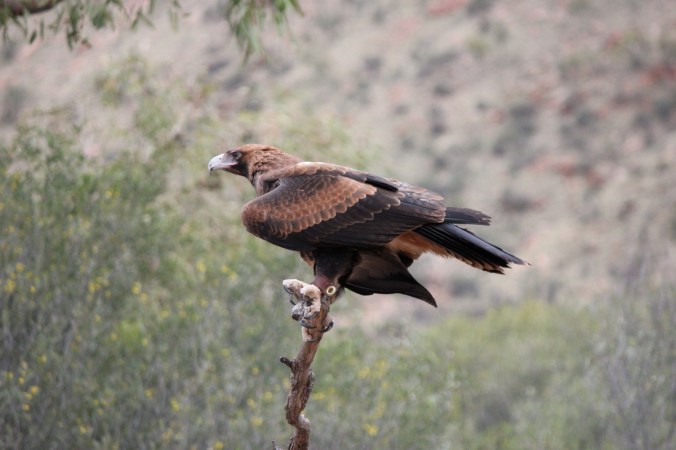
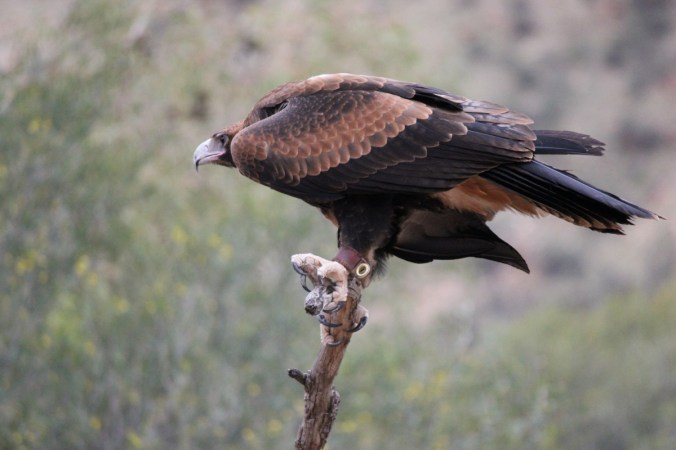

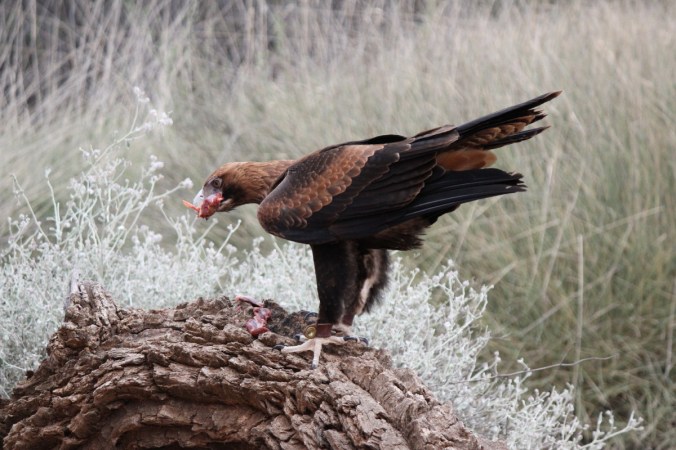 Check out his Wedgesticks(drumsticks) and not to mention his talons!
Check out his Wedgesticks(drumsticks) and not to mention his talons!

 And of course that big rudder at the back-wedge tail. Need to know more?? Click
And of course that big rudder at the back-wedge tail. Need to know more?? Click 

























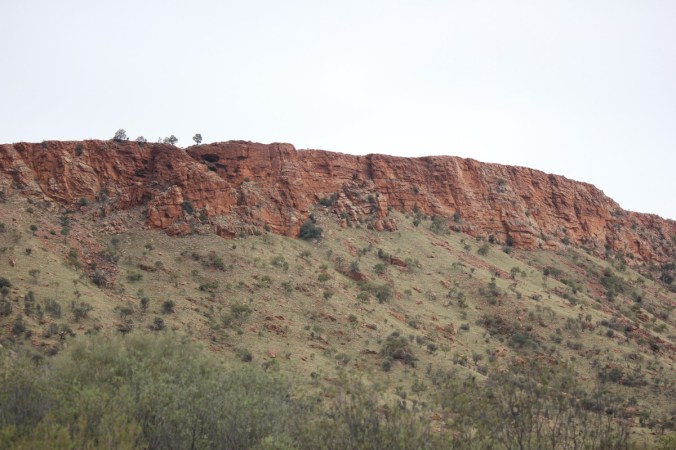
 Of course there are plenty of other animals here, this is only a snapshot of a few. I will finish with one of our most iconic marsupials, Big Red. Macropus rufus.
Of course there are plenty of other animals here, this is only a snapshot of a few. I will finish with one of our most iconic marsupials, Big Red. Macropus rufus. Cheers!
Cheers!






